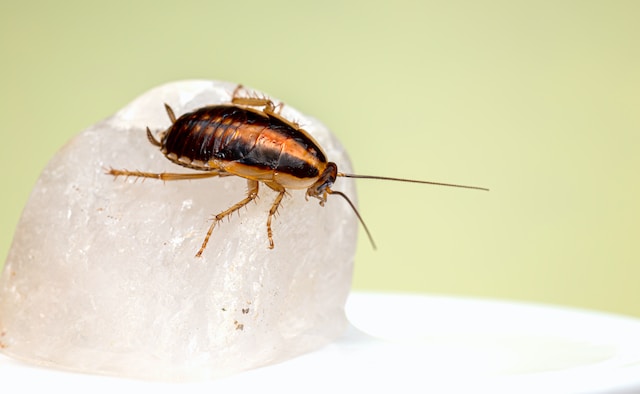Cockroaches are renowned for their resilience and adaptability, surviving millions of years on our planet. These creatures undergo a remarkable life cycle that showcases their unique ability to thrive in diverse environments.
Understanding the life stages of a cockroach offers insight into their journey from egg to adulthood and sheds light on their incredible adaptation mechanisms. Take a look at our blog, where we’ll discuss cockroach lifecycles, from egg to adult.
Egg Stage
The life stages of a cockroach commence with the egg stage. Female cockroaches produce egg cases known as oothecae. These oothecae safeguard eggs, acting as a protective casing until the nymphs are ready to emerge.
The female deposits the ootheca in a sheltered area, providing a suitable environment for the eggs to develop. Factors like temperature and humidity significantly influence the duration of the egg stage, ranging from a few weeks to several months.
Upon reaching maturity, the nymphs inside the ootheca begin to hatch. Nymphs emerge in various numbers, depending on the cockroach species and environmental conditions.
Nymph Stage
The nymph stage represents a critical phase in the life cycle of a cockroach. As the hatchlings emerge from the ootheca, they embark on a journey of molting and growth. Nymphs resemble adult cockroaches but lack wings and reproductive capabilities. Instead, they have developing wing pads that gradually expand with each molt.
During each molt, nymphs shed their exoskeleton to accommodate their increasing size. The frequency of molting varies among species, with some undergoing multiple molts before reaching adulthood.
Adult Stage
Upon completing the nymph stage, the cockroach enters adulthood, equipped with fully developed wings and reproductive organs. Adult cockroaches are adept at surviving and reproducing, ensuring the continuity of their species.
In this stage, cockroaches actively search for mates, food, and suitable environments for nesting. Depending on the species, adult cockroaches may exhibit diverse behaviors and habits. Some species prefer nocturnal activities, while others thrive in daylight hours.
Life Span: How Long Do Roaches Live?
Cockroaches display remarkable resilience and can withstand adverse conditions, contributing to their longevity. Factors like food availability, temperature, and shelter influence their life span. Typically, cockroaches can live from a few months to a few years, depending on various environmental factors and species differences.
Because of their adaptability, cockroaches can survive in diverse environments. Many species thrive in urban settings, tropical regions, and even extreme conditions such as radiation exposure. Roaches are tough pests to beat, meaning infestations are challenging and hard to control.
Stages of a Cockroach Infestation
Cockroach infestations typically progress through several stages, starting with initial sightings or signs of cockroach activity. These pests are masters of hiding, often found in dark, secluded areas near food sources and moisture. Initial sightings might be sporadic, with a few cockroaches appearing in kitchens, bathrooms, or other areas with access to food and water.
Establishment Phase
The establishment phase marks the beginning of a more significant infestation. Cockroaches reproduce rapidly; a few sightings can quickly become a burgeoning population. During this phase, cockroaches actively seek out ideal breeding sites and create nests in hidden areas, such as behind appliances, within wall voids, or under sinks.
Reproductive Stage
As the infestation progresses, cockroaches reach their reproductive stage, intensifying the problem. These resilient pests reproduce rapidly, with females producing oothecae containing multiple eggs. Each ootheca can house dozens of eggs, and depending on the species, cockroaches can lay multiple oothecae throughout their lifetime, further exacerbating the infestation.
Infestation Spread
The infestation spreads exponentially during this stage as the population increases. Cockroaches venture further from their initial hiding spots in search of food, water, and optimal nesting sites.
They move through plumbing, ductwork, and wall cracks, expanding their territory within the infested area. With increased population density, the chances of spotting cockroaches during the day also rise.
Visible Infestation
At this stage, the infestation becomes visibly evident. Cockroaches are more active and less cautious about remaining hidden, leading to increased sightings during both day and night. Fecal matter, shed exoskeletons, and an unpleasant musty odor may become noticeable.
Critical Infestation
In the critical phase, the cockroach infestation becomes a severe problem. Large numbers of cockroaches infest multiple areas, making eradication challenging. They can cause structural damage, contaminate food, and pose significant health risks due to allergens and pathogens they carry.
Eliminate Roaches with USPS!
Here at United States Pest Services, we don’t just tackle cockroach infestations; we put an end to your pest worries at every stage of the game. Our team understands the ins and outs of a cockroach’s life cycle– we’re experts at disrupting it!
Whether it’s the early signs or a full-blown infestation, we’ve got the tools and know-how to handle it all. From tailored strategies to innovative techniques, we’re dedicated to stopping those unwanted guests in their tracks. Say goodbye to cockroach troubles with our proactive and effective solutions, designed to keep your space clean, safe, and roach-free.

